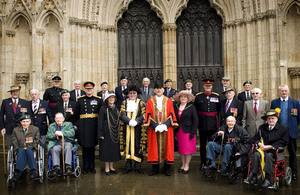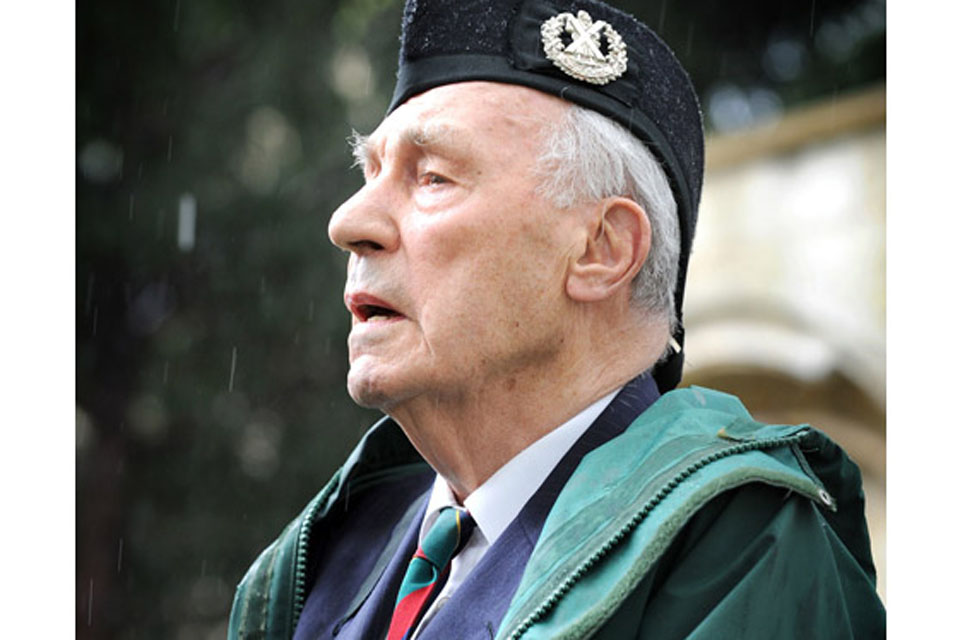Veterans remember World War Two Kohima battle
Veterans of one of the most vital and hard-fought battles of the Second World War gathered in York yesterday to remember their fallen comrades.

The 18 Kohima veterans on the steps of York Minster with senior military officials and (centre) the Deputy Lord Mayor of York, Councillor John Galvin, and the Lord Mayor of York, Councillor David Horton [Picture: Corporal Mike O'Neill RLC, Crown Copyright/MOD 2012]
18 veterans travelled from across the UK to commemorate the 68th anniversary of the 1944 Battle of Kohima, in which British and Indian forces helped halt the Japanese invasion of India.
Nearly 4,000 British and Indian soldiers lost their lives during the battle, which was fought from 4 April to 22 June 1944 around the town of Kohima in North East India. It was later described by Earl Mountbatten as probably one of the greatest battles in history and it proved to be the turning point in the Burma campaign.
The surviving veterans and their families attended a memorial service in York Minster yesterday followed by a wreath-laying ceremony in the Minster Gardens, where Major General Nick Eeles, General Officer Commanding Scotland, and Major (Retd) Gordon Graham placed wreaths on the Kohima Memorial before a bugler played the Last Post.
Speaking at the memorial, Kohima veteran Major (Retd) Graham, aged 91, from Surrey, said:

Kohima veteran Major (Retd) Gordon Graham reflects after placing his wreath on the war memorial [Picture: Corporal Mike O'Neill RLC, Crown Copyright/MOD 2012]
“It was a great privilege to represent the veterans today in laying the wreath. I’ve done it for several years, but each time still moves me. I served with the Queen’s Own Cameron Highlanders, which was an infantry regiment, and I still remember everything vividly like it was yesterday.
It was one of the last wars between foot soldiers fighting each other generally at close quarters. You met your enemy quite casually back then, sometimes to your surprise and sometimes to his.
Veteran John Skene, aged 93, added:
Today makes you remember the people who you knew. When I went back to Kohima in 1990, I saw the three cemeteries and the hundreds and hundreds of gravestones. The names on them were of chaps that I knew, who I trained with and fought alongside, and it was very, very hard to take in. You never forget.
After the ceremony yesterday, the veterans were hosted by Brigadier Greville Bibby, Commander of 15 (North East) Brigade, at a reception lunch in Imphal Barracks where they had the opportunity to browse the Kohima Museum which houses many photos, letters and memorabilia from the period, most of which have been donated by the veterans themselves.
Robert Cook, Curator of the 2nd Division Kohima Museum and Memorial Trust, said:
The Kohima Memorial Service is a great tribute to the defenders of Kohima. They stood firm against almost overwhelming odds, forcing back the Japanese invasion of India. Without their efforts and bravery our lives today would be very different.
Kohima, a town in Nagaland, North East India, was the site of one of the most crucial battles of the Second World War. In April 1944 it was besieged by a Japanese division spearheading what they hoped would be the invasion of India.
The defenders, from the Royal West Kents, the Assam Regiment and the Assam Rifles, held out for two weeks against 13,500 Japanese soldiers until relieved by their comrades of the British 2nd Division. The ensuing battle was fought at close quarters for almost three months.
It was the greatest defeat of the Japanese Imperial forces by the British and Indian Armies, and a turning point in the war in Asia.